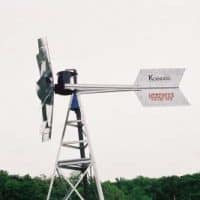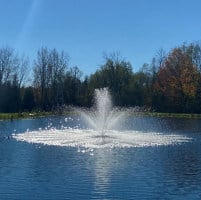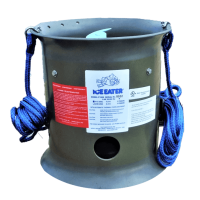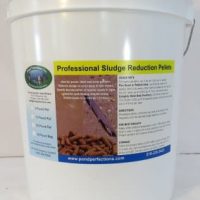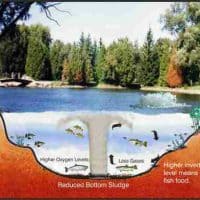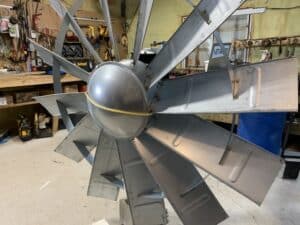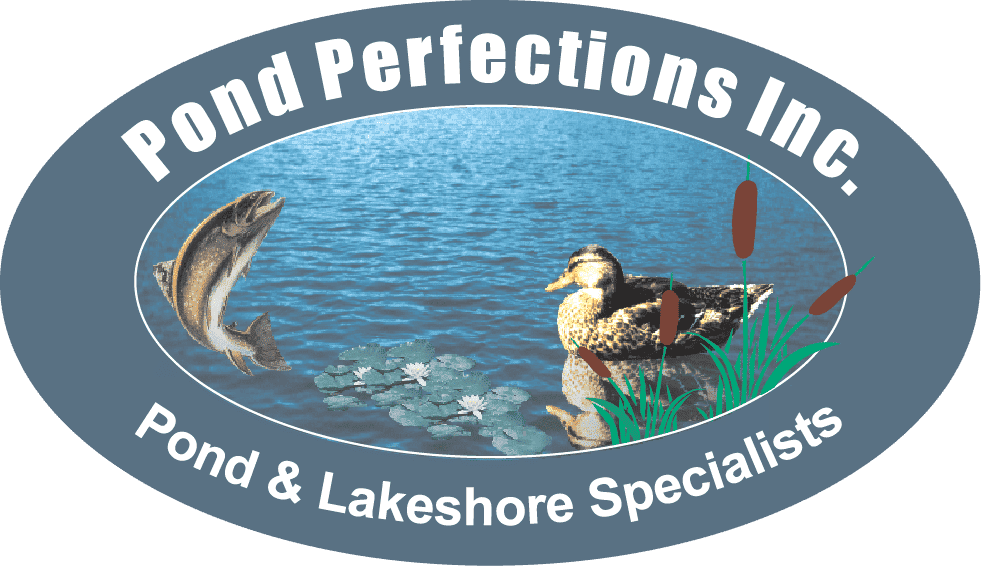FAQS
Having Questions About our products?
Windmill Repair
The main reasons are:
1. The check valves in the cannister are not closing properly
2. The diaphragm is old and may have holes and cracks
3. Leak in airline between windmill and pond – look for chew marks or hissing air
4. The air stone check valve is old and plugged
5. Bearings are worn out and have too much play
The most common reason is that the bearings are old and need replaced. If this is the case, see instructions below on how to tie off a windmill and contact Pond Perfections for Service.
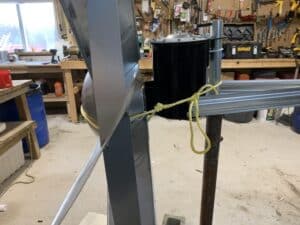
“Tie off a windmill” is the way to stop the blades from rotating, stopping windmill aeration to your pond while still allowing the windmill to pivot with wind direction. Ensure you use a strong rope (3/8 or 1/2 inch nylon). Do not tie the blades to the tower with a rope, because it will likely cut the rope or bend the blades.
If you want to stop pond aerating in the winter, install a valve on the windmill, which will stop any air pressure going to the pond.
Windmill Installation
Think of where you would like to put the windmill, stand in that spot different times for 4-6 days to check the amount of wind. Try to find a spot where there are no trees within about 100’+. When in doubt please ask, as we are happy to help you determine the right spot.
It takes 2 of our experienced crew about 5 hours to assemble a windmill. Many of our do-it-yourself customers take a day to day and a half. We can sell and ship in boxes, or have our staff install them for you. We always have several windmills built and ready to go, so if you have a trailer you can pick up a completed unit and install yourself.
If you have warm water fish like bass put the diffuser in the deepest part for the best water movement. If you have trout always keep the deepest for the trout as they need cold water to stay alive. Place it more to the shallower part of the pond. We are only a phone call away to help you with your plans.
No! it comes with 3 x 4’ pegs and we drill down about 30” with an auger, then put up the windmill. Level, then drive the pegs into the ground. Secure with bolts then put a bag of cement and gravel in each hole. These bags are at your building store and easy to mix in a wheelbarrow with a little water.
Olympus Fountain
They have been designed to operate in temperatures above 32°F (0°C). Damage will occur to Fountain units if they are left to run in freezing water and/or allowed to operate after sitting in freezing water. Many customers are successfully leaving the fountains in the water over the winter as the motor and the water pump are below ice level.
Be sure to clean the intake screen in the Spring or Fall to keep screen open. If you can it’s a good practice to take the fountain out for the winter, wash and put away in an area that does not freeze.
Pond Perfections Inc. will not be held responsible for damage to a fountain as a result of operating the unit in temperatures at or below 32°F (0°C).
Determine length from where the location of fountain will be in the pond to your main power
source. Add 15 ‘ to that length, as the power cable has to run down to bottom of pond and up to fountain. Longer and stronger cords are required to prevent amperage drop.
The heavy-duty float with an anti-fouling screen surrounds the rugged motor assembly. It is
designed to handle heavy sediment from corrosion-resistant construction materials which
withstands harsh conditions in fresh water and unique water chemistries often present in fountain applications. The motor shell is constructed from #316 stainless steel, and the motor shaft from #303 stainless steel with motor shaft nitrile rubber slinger to prevent sand and dirt from accumulating. The assembly also contains an internal heavy-duty, hard-faced mechanical seal with stainless steel components to keep assembly watertight.
Pond Perfections is located in Wingham, Ontario but ships coast to coast across Canada. Olympus Fountains are popular in the USA as well, and available at Bearon Aquatics in Maryland.
True Blue Water Dye helps block out the sunlight to weeds and algae, reducing their growth. With less weeds growing, it provides an opportunity for the good natural bacteria in the pond a chance to catch up, which will in turn increase the oxygen level to speed plant and sludge decomposition. The less organic matter growing in your pond – the cleaner the water quality.
Yes, True Blue Water dye is a safe vegetable based dye for use in a pond for swimming by people, pets and fish.
One packet of water dye is good for a 50 x 100’ pond. If your pond is twice the size use 2 packets, etc. Determine the size of your pond, and then use this measurement to calculate how many packets you will need for your first application in the spring. Add a packet or two monthly for rest of the summer, depending on size of pond to maintain the blue colour and weed growth prevention.
The 1-gallon jugs are the best for small ponds, as you can apply a smaller amount per application. One litre of True Blue Liquid is good for a 50’ x 100’ pond, as a first dose. Add a cup or two, along edge of pond, monthly for rest of the summer as you desire to maintain blue colour and weed growth protection you want.
True Blue Water Dye SoluPaks come in a foil-line outer package which you tear off the top and then simply throw the inside packet into the water with 2 fingers. Stand on the upwind side of the pond on a less windy day when applying.
Pond Aeration
In the spring the water is mostly clear, but as the water warms dead plants, leaves and bottom sludge start to decompose, putting particles into the water column making the water murky. The smell comes from the decomposition occurring at bottom of the pond.
Pond aeration is the process of adding oxygen to pond water to improve water clarity and overall pond health. It takes oxygen for bacteria to break down sludge in the lower pond water where carbon dioxide, sulfur, nitrates, and other gases are in higher density. This process is called degassing, which is removing the nutrients that feed algae and pond weed growth. Bottom and Surface aeration systems are available to infuse water with oxygen, depending upon your requirements and end goal.
Often brown water is caused from goldfish, carp, or catfish, which are bottom feeders. Bottom feeder fish constantly are digging up pond sludge looking for food, forcing the organic matter up into the water column. The type of trees and vegetation around the pond area could also cause pond water to be brown. When leaves and debris land in a pond they will sink to the bottom in the Fall and start to
decompose. In the Spring as the water warms, decomposition will continue, and smaller particles of the leaves and debris will float up suspended in the top few feet of water while they decompose, making the water brown.
Solutions to clear brown pond water:
1. Pond Clarifier – Beneficial Bacteria in packets can be used in ponds with little or no outflow. Pond Clarifier comes in 1⁄2 pound water soluble packets, easy to throw into a pond. The enzymes break down the algae or particles allowing the bacteria to consume it, cleaning the water column, and speeding up overall pond decomposition.
2. Aeration – Good aeration degasses the nutrients through out the pond cleaning the water and reducing any aquatic growth, depending on the size, depth and water flower of the pond.
3. True Blue Water Dye – blocks out the sunlight to the weeds and algae in deeper water, to
lessen or prevent growth.
As the pond water warms it speeds up decomposition, releasing nutrients into the water feeding the green algae. There are two types of algae commonly found in ponds – planktonic algae or filamentous algae. Filamentous algae is caused by dead weeds and debris decomposing on the bottom. As algae grows it gets more buoyant and breaks off floating up to the surface and looks like a mat of green, sometimes covering large parts of a pond. Generally filamentous algae is found around the pond edge or everywhere in a shallow pond where sunlight can get to it. Planktonic algae is caused by the same decomposition as Filamentous algae, but floats in the top 2-4 feet of pond giving pond water a greenish appearance.
To get rid of these types of algae, there are four options:
1. Aeration – Good aeration degasses the nutrients through out the pond cleaning the water and reducing any aquatic growth, depending on the size, depth and water flower of the pond.
2. True Blue Water Dye – blocks out the sunlight to the weeds and algae in deeper water, to lessen or prevent growth.
3. Pond Clarifier Beneficial Bacteria in packets can be used in ponds with little or no outflow. Pond Clarifier comes in 1⁄2 pound water soluble packets, easy to throw into a pond. The enzymes break down the algae cells allowing the bacteria to consume it, cleaning the water column, and speeding up overall pond decomposition.
4. Sludge Reduction Pellets are bacteria (same as Pond Clarifier), but in a pellet form. Pellets are excellent for spot treating problem areas around shorelines, docks, or swimming areas. Bacteria in packets or pellet form are great at preventing algae growth. Best recommendation is to use bacteria before there is algae growth in your pond.
An aeration solution for your pond will depend on several factors:
• What is the length, width, and depth of your pond?
• Is there water outflow from the pond?
• Is there a lot of trees or bushes around the pond?
• Do you have access to hydro near the pond and how close is it?
• Is there adequate wind flow available in the pond area, if a windmill is required?
Pond aeration can be accomplished through bottom aeration, windmills, fountains, or surface aerators. Based on your pond specifications we will recommend an aeration system to fit your needs.
Give us a call to discuss the details and determine the best solution for your pond.
Sludge Reduction Pellets
Spot Treatment Application Guide
Throw pellets around the outer 20’ of the problem sludge areas of ponds, docks, boat houses
and shorelines to reduce bottom sludge.
Summer (five month) Treatment for 4000 Square Feet Area:
50 LB bag required
For 4 weeks apply 8 LBS per week
Every other week afterwards apply 2 LBS, as needed.
Summer (five month) Treatment for 2000 Square Feet Area:
25 LB pail required
For 4 weeks apply 4 LBS per week
Every other week afterwards apply 1 LB, as needed.
Tip: For easy figuring there are 3 cups of pellets to a LB Pellets available in 5, 10, 25 LB pails, and in 50 LB bags.
Speed up sludge decomposition by combining the use of an Aquatic Weed Roller and Sludge
Reduction Pellets.
1. Scatter pellets as required with above quantities
2. Roll over area with Aquatic Weed Roller, which will bury pellets into sludge, and speed
up decomposition.
Yes, pellets can be ordered in skid lots. Call for discount pricing, and please allow for lead time on larger orders.
In Summer months store pellets out of direct sunlight in a cool dry area.
In Winter months store pellets in an area where they will not freeze. For best results, use pellets within 12 months.
POND CLARIFIER Beneficial Bacteria
Pond Clarifier Sludge and Water Quality Bacteria treatment is used to improve water clarity in ponds where water is green (planktonic algae), water is brown (from goldfish or decomposing leaves or debris from prior years), or filamentous algae is growing.
Pond Clarifier bacteria in packets can be used in ponds with little or no outflow. If you have water flowing in or out of pond, then we recommend spot treating areas with our Sludge Reduction Pellets, which are made of the same bacteria.
Ponds have a natural level of good bacteria which helps to clean and improve the health of the water. The quantity of natural bacteria may not be sufficient in ponds that have a high nutrient load, caused by excessive dead plants, algae, and lower oxygen levels. By adding Pond Clarifier Professional bacteria to a pond you increase the bacteria which cleans the water column and speeds up overall pond decomposition of sludge.
Pond Clarifier Beneficial Bacteria is manufactured for Pond Perfections by Great Lakes Bio Systems, leaders in bacteria and enzyme cultures. Together we have fine tuned this bacterium over many years, and as a result a leading edge product has been created formulated specifically for Canadian colder temperatures to clean pond water.
Pond Clarifier comes in 1⁄2 LB water soluble packets, which you simply toss into the pond.
For a pond 50’x100’ with brown, murky or cloudy water use 8-10 packets every 3 weeks. As the water quality improves, reduce the number of packets put in ever 3 weeks.
For a pond 100’x100’ use 15-20 packet every 3 weeks. As the water quality improves, reduce the number of packets put in ever 3 weeks. For ponds near an acre in size throw in 25 packets every 3 weeks.
Then again as the water quality improves reduce the number of packets thrown in. There are 50 1⁄2 LB packets in a 25 LB pail. Pond Clarifier is available in 5, 10 and 25 LB Pails.
Pond Clarifier comes in 1⁄2 LB water soluble packets, which you simply toss into the pond.
For a pond 50’x100’ with brown, murky or cloudy water use 8-10 packets every 3 weeks. As the water quality improves, reduce the number of packets put in ever 3 weeks.
For a pond 100’x100’ use 15-20 packet every 3 weeks. As the water quality improves, reduce the number of packets put in ever 3 weeks. For ponds near an acre in size throw in 25 packets every 3 weeks.
Then again as the water quality improves reduce the number of packets thrown in. There are 50 1⁄2 LB packets in a 25 LB pail. Pond Clarifier is available in 5, 10 and 25 LB Pails.
Ice Eater / Aquatic Weed Blower
The Ice Eater comes with a 3-year warranty from the date of manufacture by Bearon Aquatics. When the Ice Eater is used for purposes other than de-icing, such as in the summer as an Aquatic Weed Blower a one (1) year limited warranty shall apply.
For Best Results use commercial grade GFCI on all equipment.
Replace propellers when worn or jagged. Propellers in good condition keep the motor running at top speed/performance. Worn or jagged propellers add drag to the motor and can ultimately damage the motor and void your warranty.
Tip: Remove an existing propeller by holding the shaft and turning the propeller counter clock-
wise.
Ice Eaters / Aquatic Weed Blowers should be stored propeller side down.
Tip: While you have your Ice Eater out of the water, it is a great time to give the whole unit a good inspection. Make sure nothing is tangled around the shaft (fishing line or weeds). Look over the propeller to make sure it is not worn or jagged. Check the anode for erosion (order replacement when it’s about half-size). Give your equipment a bath to eliminate any gunk build-up for longer-lasting equipment and definitely clean the can!
We recommend a degreaser (let it sit for a few minutes) and then power-wash the whole thing.
Size, depth, and water conditions are only a few factors used to determine which of our products will best satisfy your needs. With extensive knowledge and years of experience, we will work with you. We know the right questions to ask and will quickly determine which product, size, and application you need.
We are only a phone call away.
